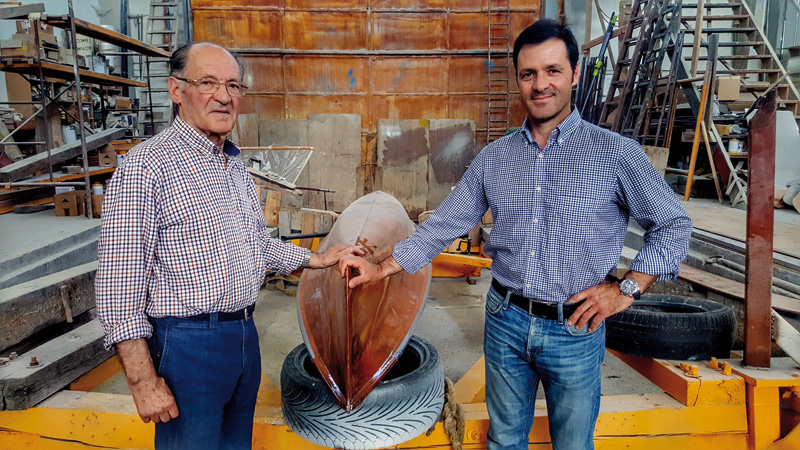The sea from hand to hand
- Faced with the impossibility of governing the sea, peoples who are born, grow and live looking at the ocean have set their minds on guessing how to govern oneself in the sea. Hondarribia and the other peoples of the Basque coast have done the same. It has done them well and has led them to become leading producers who have been trained for centuries in the shipbuilding industry. But the future, like the sea, is in the fog.

In the streets, ports and banks of the rivers of Euskal Herria, renowned vessels and boats have emerged and worked. Beyond the beaches and cliffs, the interior also grew looking at shipbuilding at a very long time, keeping hand in hand the powerful sector that led history, culture, society and economy from generation to generation.
However, the sector is no longer strong and does not perform engine or candle functions of the economy. It remains. You can even say that you are looking for the north, at a time when you have to fish coupons and other measures necessary to fish in remote offices. It takes more than a good boat to get out into the sea.
Centre of the Province
Hondarribia has played a special role in this field. The impressive work of Naval Construction in Hondarribia 1203-2003, published in 2003 by Dr. Lourdes Odriozola Oyarbide along with the City Hall of Hondarribia, narrates in detail the flow of the last eight centuries.
In 1203 he founded the village of Hondarribia Alfonso VIII.ak, king of Castile, to control the strategic river Bidasoa and guarantee trade relations with Atlantic Europe. Until the 18th century, the country’s largest shipyards were on the banks of Lezo and Pasai Donibane, which, according to Odriozola, “made Hondarribia in the Modern Age one of the province’s main naval production centers.”
The oil of that time was whale fat, and Hondarribitarras were excellent whale fishermen. At first they used small boats with a maximum of ten meters and five remers, but as the whales moved away from the Basque coast, the fishermen also built boats to go further, like Ternua.
In the thirteenth century, the naval innovations that the Basques learned from them came to the countries of northern Europe. The boats managed to adapt to their own needs by improving the skills learned and advancing in the sector, until reaching a high degree of perfection in the 15th century and being recognised throughout Europe. Bateles, whales, boats, chalk, naos and whales were built mainly in the Middle Ages.
At this time all the shipyards were outside the village wall: “Boat construction trolleys from the Arenal of the Santa Maria Gate to the so-called La Roca”. In addition, the shipyard of the old mill, which appears in a 1612 document, the Ribera shipyard, where in 1545 Captain Sancho Alkiza built a nao, the Lonja or Puntal, the Magdalena shipyard, the Bordonda shipyard, the Real Astillero of the Bizkaia district, the Irun shipyard and the Pastillos.
In this golden era of Basque shipbuilding various types of vessels were made, such as the loss (16th century). In the 18th century), nao and galleon (XVI and XVIII), nave (XVIII)… Later came fragata, bergantina, lega, batel, barca, boat, trainera, chanela, etc. During these years many important boats have been made in Hondarribia.
New times
The first modern shipyard in Hondarribia was the Aseginolaza shipyard located opposite the San Pedro Cofradía. In 1928, the secuinolazarras built the second pavilion and managed to assemble a wide and varied machinery. In the 20th century they have joined the sector named Urtizberea, Errazquin, Ecenarro, Elzo, Zuzuarrangi, Lekuona, Garin or Sagarzazu. But, above all, there are two surnames that have borne the witness of the shipbuilding in Hondarribia until the twenty-first century: Olaziregi and Iridoi.
Juan Iridoy, known as Raku, began working in the yard Aseginolaza at the age of 12. On the return of the war he decided to make his own riverside workshop. He worked there for 40 years until in 1972 he retired and passed the witness to his sons José Luis and José María. It was built and continued to work for three more decades in the pavilion currently housed by the Club de Remo de Hondarribia. Although the new generation also produced wooden fishing boats and some polyester fishing boats, repairs had a great deal of weight in the Ragon’s activity until the end of the shipyard.

Lázaro Olaziregui founded the yard a couple of years later than Iridoy, on Pampinot Street. He also learned the trade in Aseginolaza. He later built the pavilion in the neighborhood of Amute, passing through Almirante Alonso Street. After observing in the Barcelona Marine Exhibition of 1965-1966 polyester boats, the sons of Lazarus, Ignacio and Ramón began to use this material for the manufacture of small motorcycles and boats. During these years, hundreds of such productions took place.
Ignacio and Ramón worked together until 1991. Ignacio and his son Lazarus are still in Hondarribia, after settling in Gabarrarin, and they have worked mainly on polyester to produce small motorcycles and inshore boats.
Next generation
Lazaro, named after his grandfather, learned his father's trade at the age of 13, starting at the workshop. Hand-to-hand transmission has been common. The hobby for the trade also arose from the presence of his father in the workshop. All of them were carpenters and had patience, passion for what they knew how to do, courage, fine hand and good eyes as work tools.
But they're slippery. The sector is weak, with no fixed course, shipbuilding subsidies are over and new generations are in difficulty. Lazarus does not believe that his future will be working in the shipyard, but he is hopeful that he will.
Naval engineer Enrike Lekuona has made many of his designs at the Iridoi shipyard. Lately, the wisdom of the fishermen talks about the wisdom that has been generated and transmitted between the seafarers, the fishermen and the shipowners, and the ways of doing it.
Concerns about the future of fisheries and shipbuilding: “These are bad times for selective fishing that we have here and we have to go out into the world to look for new business models. Not only that, in Euskal Herria we have the conditions to return to work in the construction of leading boats, but there is a lack of wager and investment. Like CAF or Irizar, the situation can be reversed.”

Langileek hiru hilabeteko erregulazio espedientea onartu dute, kable-ontzia amaitzeko “bermeak” edukitzearen ordainetan. Gaur aurkeztuko du konkurtsoa ontziolaren zuzendaritzak.
Armadorearen hainbat marinel gauez azaldu dira Sestaoko ontziolara eta amarrak askatzen saiatu dira azalpenik eman gabe. Langileek Ertzaintzari abisua jo ostean alde egin dute.























